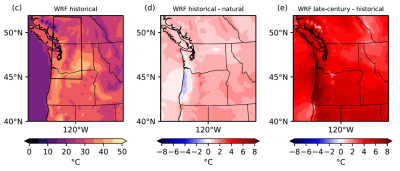Anthropogenic Contributions to the 2021 Pacific Northwest Heatwave
Daily maximum temperatures during the 2021 heatwave in the Pacific Northwest (PNW) of the United States and Canada shattered century-old records. Multiple causal factors, including anthropogenic climate change, contributed to these high temperatures, challenging traditional methods of attributing human influence. We demonstrate that the observed 2021 daily maximum temperatures are far above the bounds of Generalized Extreme Value distributions fitted from historical data. Hence, confidence in traditional causal inference statements about the human influence on this heatwave is low. Alternatively, we present a more conditional hindcast attribution study using two regional models. We performed ensembles of simulations of the heatwave to investigate how the event would have changed if it had occurred without anthropogenic climate change and with future warming.
We demonstrate that out-of-sample fitted non-stationary Generalized Extreme Value (GEV) distributions fail to contain many of the observed 2021 observations within the uncertainty estimates of their upper bounds. We, therefore, conclude that estimates of the PNW heatwave return times are not accurate and that confidence in GEV-based estimates of the human influence on the change in the probability of the observed extreme temperatures should be low. We further conclude that quantitative estimates of changes in event magnitude and frequency from CMIP-class models are made with low confidence as it is not clear that global climate models adequately simulate the relevant meteorological phenomena of the PNW heatwave even if they simulate extreme temperature anomalies as high as observed. We present an alternative but more limited attribution of the anthropogenic changes to the PNW heatwave using ensembles of simulations from the regional models WRF and RegCM, where the hindcast attribution method was used to examine the effects of removing anthropogenic warming and additional future warming.
While it is clear that global warming causes heatwaves to be warmer, the unique meteorological conditions behind the 2021 Pacific Northwest heatwave tax our ability to make quantitative estimates of human contribution. We discuss why there is low confidence in traditional estimates of the human contribution to this heatwave's temperatures and present an alternative, albeit more highly constrained, estimate that human activities caused a ~0.8-1oC increase in the observed daily maximum temperatures. Additional future warming could lead to a ~5oC increase in the heatwave by the end of the 21st century.

